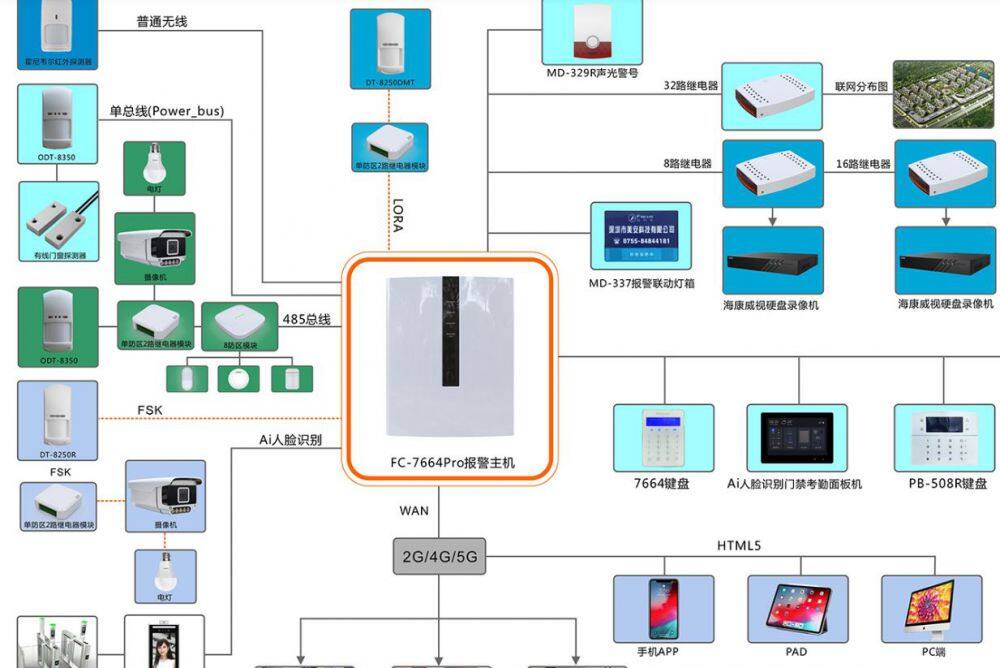-
 Sarah Huang
Hi there! Welcome to my shop. Let me know if you have any questions.
Sarah Huang
Hi there! Welcome to my shop. Let me know if you have any questions.
Your message has exceeded the limit.

Common wired security alarm system working principle
2025-10-27 23:23:50
Security system is mainly divided into three blocks: monitoring, alarm and access control. In the security group, we shared a lot of things about video surveillance, so today we will talk about alarm system. Our common security alarm system is mainly divided into wired and wireless. Most of the home alarm is wireless, because it is easy to install, no cable constraints, and does not destroy the overall environmental style of the home, so it is deeply liked by home users. Smart home security products are mainly based on wireless alarm and monitoring.
But in the business environment, or systems engineering, the disadvantage of wireless appears. Therefore, wired burglar alarms are trusted by most engineers because of their stability and affordable price, but for personnel who are generally not professionals, it seems that it is a little difficult to connect wired detectors and burglar alarm hosts.
We know that the main components of an anti-theft alarm system are composed of three parts: alarm motherboard, front-end detector and alarm transmission device (network alarm communication and on-site sound and light alarm).
The front-end detector includes passive infrared, infrared plus microwave double detection, infrared through-beam, infrared guardrail, manual alarm, fire house detection, glass breakage, etc., which are suitable for different environments according to different functions.
The front-end detector is the sensor of the alarm system, and the detection of the external alarm situation by the alarm system is completed through the front-end detector. As far as the connection and signal transmission between the front-end detector and the alarm host are concerned, in the final analysis, it is a switching signal transmission and reception process. The so-called switching signal is the process of opening and shorting an electrical circuit.
Taking the conventional alarm system generally adopts normally closed working mode as an example, when the system is powered on normally, if the detector is powered off or triggered by the alarm, the relay in the detector sends out an action, the contact changes from the closed state to the disconnected state, when the alarm host detects this change in the corresponding defense zone port, it will take corresponding reactions according to the current state settings (including ignorance, alarm, signal output, etc.).
In fact, the working principle of alarm host and alarm detector is very simple, but why many people in practice cannot be properly configured and used, in fact, some key basic knowledge is not well understood. Today, let’s talk to you about the wired defense zone and the connection between the wired detector and the alarm system.
The basics can’t be less: what is end-of-wire resistance.
End-of-line resistance (or end-of-line resistance) English EOL Resistor: End-of-line resistance (EOL, End of Line) circuit, the circuit is characterized by the loop terminal access resistance, the short circuit to the ground will trigger the circuit contact action, such as when the system is armed, the loop is broken or short circuit will trigger an alarm. The scientific name is end-of-line resistance, the specific specifications of end-of-line resistance different brands and models of alarm hosts have their own specifications, the resistance of each manufacturer is different, commonly used are 1KΩ, 2.2KΩ, 4.7KΩ, 5.6KΩ, 6.8KΩ, installed on various detectors, that is, the end of the line.

With normally closed circuit, the EOL is connected in series to the circuit, with normally open circuit, the EOL is connected in parallel to the circuit, when alarming, the host will detect the change of resistance value, in other words, as long as the resistance output to the host is not the nominal resistance value (such as 4.7KΩ), the alarm will be alarmed. The task is to prevent vandalism, and you will also call the police if you cut the line or short circuit.
To put it very clearly, there are two ways of end-of-line resistance: one in series and one in parallel.
Normally closed loop (NC): normal short circuit, open circuit alarm. The disadvantage of this circuit formation is that if someone shorts the line, the probe loses its effect. The alarm host cannot identify the human short circuit.
Normally open loop (NO): short circuit alarm, open circuit normal. The disadvantage of this circuit formation is that if someone breaks the line (cuts the signal line), the probe loses its effect. The alarm host cannot identify the section that is human.
Line tail resistance EOL: normal short circuit, open circuit alarm. The advantage of this circuit formation is: if someone breaks the loop line (short circuit back circuit), the alarm host can alarm. Short circuit alarm, open circuit fault, resistance value (such as 4.7KΩ) is normal. The advantage of this circuit form is: different reactions to short circuits and open circuits, especially suitable for smoke detectors and emergency buttons, if it is a mouse bite or tears off due to helping something, the alarm host thinks that the circuit is faulty.
Therefore, in practical applications, without passing the detection of end-of-line resistance, but simply connecting normally closed and normally open circuits, there are great alarm safety risks.
Meaning of alarm host AUX, Z-, Z+:
Unlike wireless detectors, which use battery power, wired detectors are usually powered by DC voltage, and the AUX of the alarm host provides power to the wired detector at the detector power output. Usually the voltage value output of the alarm host AUX is DC12V, DC14V.
Z- represents the negative pole of the wired defense zone, generally Z-ground (GND), Z+ represents the positive pole of the wired defense zone, usually with a certain voltage.
Tags: alarm system, security alarm, wired security alarm

